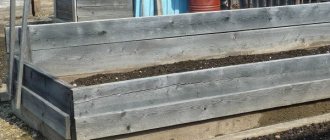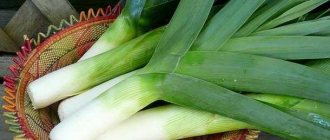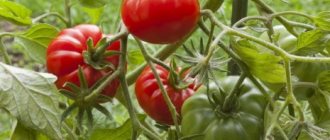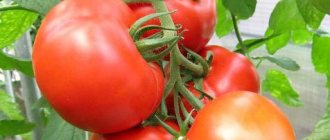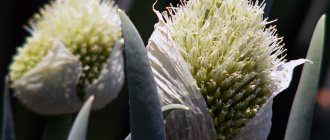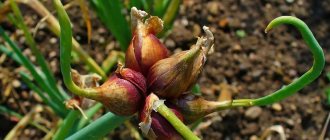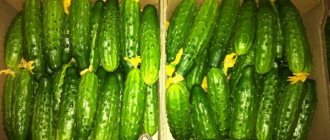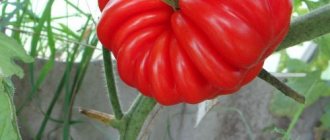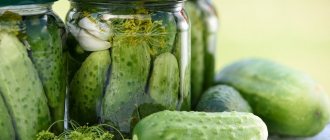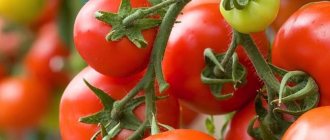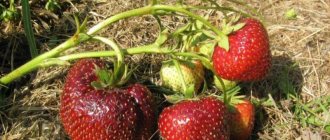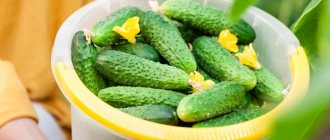It’s rare to find a garden that doesn’t have cucumbers. Vegetable growers grow them in beds and under film, choosing a wide variety of varieties or hybrids for this. Cucumber Rodnichok F1 is one of the most famous and in demand varieties of the crop. This is an old hybrid, obtained by Soviet breeders, which in terms of basic agricultural qualities (yield, disease resistance and taste) is still able to compete with new and fashionable cucumbers of domestic and foreign selection. Let's consider its advantages and rules of agricultural technology.
History of variety selection
The cucumber variety Rodnichok was included in the State Register in 1979, although the date of application was 1974. Its author is breeder A. A. Mashkov, an employee of the Transnistrian Research Institute of Agriculture located in Tiraspol. This is the first of the hybrids that is immune to powdery mildew and other diseases that can be grown in a greenhouse.
Subsequently, the cucumber Rodnichok became a genetic source of the absence of bitterness in the fruits and complex resistance to infections for other varieties. This hybrid is recommended for cultivation in open ground, greenhouses and under film covers throughout Russia.
Advantages and disadvantages
Rodnichok cucumbers are rightfully considered one of the best varieties of this crop that can be planted in your garden. They are in high demand among gardeners due to the fact that:
- they can be planted both in beds and in greenhouses;
- form long productive lashes;
- they produce greens that are even and uniform in size, so there is no need to sort them;
- have excellent taste;
- universal in use.
The fruits of the hybrid Rodnichok F1 can be grown both for yourself and for sale: they enjoy well-deserved popularity among buyers, so they are always quickly sold.
The disadvantages of Rodnichka are that with insufficient watering, greens begin to taste bitter, and these are only suitable for conservation, as well as the huge difference in the yield of bushes cultivated in open and protected ground.
Description of cucumbers Rodnichok F1
The main shoot of the cucumber, Rodnichok f1, reaches three meters, the lateral branching is not very strong - 4-5 lashes are formed during the entire growing season. Each node produces 2-3 flowers (mostly of the female type), from which green flowers develop. The root system of the Rodnichok variety, like all cucumbers, is weak.
Description of fruits
The cucumber variety Rodnichok, the photo of which is presented below, produces beautiful light green fruits with white stripes on the sides and sparsely spaced black thorns. The shape of greens is cylindrical, marketable size is 9-12 cm, weight is 90-110 g. Description of Zelentsy cucumbers will be incomplete if it is not noted that its fruits are leveled and do not need calibration. This is important for farmers, as it allows them to reduce financial and labor costs.
Rodnichok cucumbers have an excellent taste, they are not bitter at all, the flesh is juicy and crisp. Zelentsy are stored for a long time and do not turn brown; they are easily transported over long distances. The seeds are small and practically unnoticeable, the peel is thin but durable.
Comment! Despite the “advanced” age of the variety, the characteristics and descriptions of Rodnichok cucumbers, as well as consumer reviews, allow us to call it one of the best bred by world selection.
Characteristics of cucumbers Rodnichok
The variety Rodnichok F1 is very attractive for cultivation. Private farms provide themselves with tasty vegetables, and large and small farmers receive high profits. With the same care, Rodnichok cucumbers on the fresh produce market are much more expensive than other varieties (sometimes 2-3 times).
Productivity and fruiting
The Rodnichok variety is a hybrid, but must be pollinated by bees. Fruiting is extended, beginning in the middle period - more than 7 weeks (50-55 days) after the seeds hatch. Usually the first greens are harvested at the end of June in the south or beginning of July in other regions.
In open ground, the yield of Rodnichok cucumbers ranges from 5-7 kg per square meter. m. In a greenhouse, when grown on a trellis, the variety can produce 17, and with good care - 25 kg per square.
Agricultural technology affects the yield - if the crop is not maintained correctly, you may not get cucumbers.
Application area
Greens of the Rodnichok F1 variety are most often eaten fresh due to their high cost, long-term storage and excellent taste. But they can be salted, pickled, used for winter salads and other preparations.
Resistance to diseases and pests
Rodnichok cucumbers are resistant to true and downy mildew and other diseases. In breeding, they are used to create other varieties and hybrids as a donor of genetic resistance to a whole range of infections affecting the crop.
In open ground, Rodnichok cucumbers can be affected by aphids - the plant should be treated with soap solution, ash or other folk remedies. If pests infest a greenhouse, it is not the variety’s fault, but the owners’.
Advantages and disadvantages of the variety
According to numerous reviews, Rodnichok cucumbers have no drawbacks (except for the average ripening time and the inability to get their own seeds). Of course, you might want them to produce a ton of greens per bush, grow as a tree, or not respond to heat or cold at all. Or so that Rodnichka does not need to be looked after. But this is already fantastic. The undoubted advantages of the Rodnichok variety include:
- Great taste.
- Zelentsy do not outgrow for a long time and are stored well without loss of commercial quality.
- Rodnichok cucumbers can be transported over long distances.
- Beautiful appearance.
- The fruits are one-dimensional and do not require sizing.
- High resistance to diseases.
- Possibility of growing in greenhouses, open ground, under removable shelters.
- Zelentsy are suitable for fresh consumption and all types of processing.
- No bitterness.
- High yield (especially in greenhouses).
Reviews from vegetable growers
Vegetable growers most often classify “Rodnichok” cucumbers as classic, tried and tested Russian varieties, suitable for cultivation in almost any conditions. Zelentsy are good fresh or canned. This hybrid can be found both on personal plots and in farm greenhouses. Cucumbers have a very beautiful shape, green even color. All greens are neat and convenient for preservation, and are also very tasty when pickled.
Experienced gardeners spray cucumber bushes with a soap solution or infusion of tomato tops to prevent diseases. Plant care consists of watering, weeding, loosening and mandatory fertilizing with organic fertilizers to stimulate a healthy and high harvest. Collected greens do not turn brown during storage, yellow discoloration does not form, they are in great demand among consumers.
Growing cucumbers Rodnichok
The Rodnichok variety was bred specifically for greenhouses. True, it is also planted in open ground, but there the cucumbers feel much worse - they suffer from unfavorable weather factors, sometimes even get sick, and produce much less greens.
Planting seedlings
Cucumber seedlings are grown in order to get the harvest 1-2 weeks earlier. This is justified for greenhouses and northern regions; in the south, in open ground, it is better to plant Rodnichok F1 cucumber seeds directly into prepared soil.
It is better to take large containers at once - at least 0.5 liters. Not a single variety of cucumber will survive picking - they generally do not tolerate transplantation well.
The coated seeds do not require any preparation - the manufacturer has taken care of this. There is also no need to warm them up before planting - hybrids already form mainly female flowers. Seeds without shells are pre-soaked for a short time (15-20 minutes) in hot (53⁰ C) water. You can soak them in an epin solution for several days to germinate and stimulate your own immunity.
Then the seeds are planted in containers to a depth of 1 cm, 2-3 pieces each, covered with glass or film, kept at a temperature of 25-28⁰ C. Every day, the cucumbers are ventilated and sprayed with warm, settled water from a household spray bottle.
Comment! Typically, the seeds of the Rodnichok variety germinate quickly - in 2-4 days.
After the emergence of seedlings, the shelter is removed, and in order to prevent the seedlings from stretching, they are moved to a cool (15-17⁰ C) place. After another week, the seedlings are placed at a temperature of 19-20⁰ and good lighting.
When 2 true leaves appear, the cucumbers are fed with complex fertilizer, dissolving 1 teaspoon in a liter of water. 1 plant is left in each container, the rest are carefully cut with scissors from the manicure set. At the age of 20-25 days, the seedlings are transplanted into the ground (May 15 - June 5) or a greenhouse (from May 10 to 20).
Important! You can’t delay it – overgrown cucumbers don’t take root well.
Growing cucumbers using the seedless method
The soil is prepared in the fall or 2 weeks before planting. To do this, the area is dug up to a depth of 20-25 cm, for each square. m add a bucket of organic matter (humus or compost), fertilizers:
- phosphorus – 30-40 g;
- potassium – 15-20 g;
- nitrogen – 20-25 g.
Acidic soils need improvement - per sq. m add a liter of lime or dolomite flour.
Holes are made with a diameter of 30 cm in 1-2 rows if the lashes will be located on the ground. Each is well watered with warm water and 2-3 seeds of Rodnichok cucumbers are planted. Then fill in 1 cm of soil, humus or peat. Don't water.
To grow cucumbers on a trellis, make furrows and moisten them well. The seeds are planted at a distance of 15 cm from each other and filled in the same way as in the holes.
Aftercare for cucumbers
You need to care for the Rodnichka in the same way as other cucumbers. This variety can bloom and bear fruit for a long time, so if you want to get a good harvest, follow these rules:
- Plant cucumbers in a sunny but sheltered location from the wind.
- Water them frequently and deeply, but not excessively, to prevent rot. The water must be warm - cold water will destroy the plants. In cloudy and cool weather, limit watering, but do not let the soil dry out.
- Every week after watering, feed the cucumbers alternately with organic and mineral fertilizers.
- In heat exceeding 35 degrees, shade the crop. When the temperature drops to 12-14⁰ C and below (at 10, cucumbers die), cover the planting with lutrasteel or agrofibre.
- If necessary, carry out treatments against diseases and pests. Try to use biological drugs or folk remedies.
Important! Cucumbers love potassium and suffer from a lack of it. When feeding, make sure that the bushes receive this element (you can use ash).
Bush formation
The cucumber variety Rodnichok usually forms only when grown on a trellis. The main shoot needs to be pinched when it reaches the top row, and the side branches should be pinched above the third node.
Further care of plants
Growing cucumber requires compliance with agrotechnical rules. Vegetable growers carry out regular watering, apply fertilizers, remove weeds, and take preventive measures against diseases and pests. When the first symptoms are detected, folk or traditional remedies are used.
In the open ground, grooves are dug near the beds. Humidification is carried out with warm water in prepared trenches. The soil is moistened as it dries. Plants indoors are watered regularly. To do this, for 1 sq. m use 4-5 liters of water at room temperature. The soil is kept moist so that air permeability is not impaired.
When buds appear, the crop is watered once every 2-3 days. The amount of water per square meter is increased by 5 liters. After flowering, ovaries are formed. During this period, plants are moistened every other day. After watering, the soil around the bushes is loosened and weeds are removed at the same time.
On a note. In hot weather, the glass of the greenhouse is watered with a chalk solution so that the crop does not get burned and does not wither.
When the bushes have 3-4 leaves, the plants are fertilized with organic matter. Next, the cucumbers are fed every 15 days with complex fertilizers. For this purpose, special drugs are used, for example, “Good Power”. Fontana f1 responds well to nettle or yeast infusion. During the formation of ovaries, fertilizers with potassium and phosphorus are added.
When the crop begins to bear fruit, the plants are fed with an infusion of green grass or mineral fertilizers.
